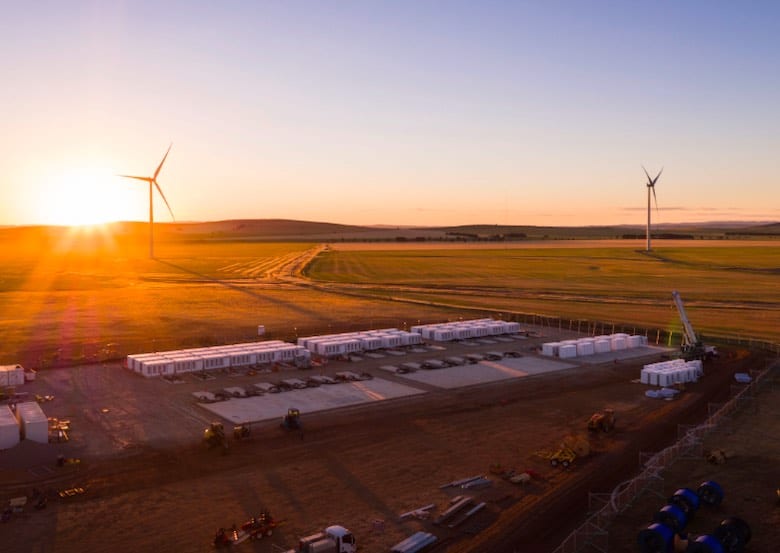

The Hornsdale Power Reserve.
South Australia’s three big batteries have again demonstrated the crucial role they play in maintaining the state’s electricity supplies, helping to avoid black-outs after the state again found itself ‘islanded’ from the rest of the National Electricity Market.
At around midday on Monday, South Australia’s electricity network was again separated from Victoria after a fault at the Heywood terminal resulted in an interruption to electricity transfers between the two states. It left South Australia fending for itself in terms of electricity supplies, a challenge it was able to meet largely thanks to the state’s abundant supply of rooftop solar, wind and battery storage.
AEMO confirmed that South Australia had been re-synchronised with the rest of the market shortly after 8:00pm and that the market operator was currently in the process of investigating the cause of the separation.
During a separation event, a region becomes “islanded” from the rest of the network, meaning no electricity can be sent in or out, and requiring it to be self-sufficient for electricity supplies until reconnected to the rest of the grid.
South Australia has two interconnections with Victoria, the Heywood interconnector and the MurrayLink interconnector, which allow for power to be shared between the states. The Heywood interconnector, however, has been the subject of several outages – the most recent caused by severe wind damage to the transmission lines that run between the two states.
Despite yesterday’s separation, there were no interruptions to the supply of power in South Australia, with the bulk of electricity used during the separation event being supplied by the state’s solar and wind resources. However, due to an inability to send excess electricity to Victoria, a number of South Australia’s wind and large-scale solar projects again found themselves curtailed to avoid too much electricity being produced in the state.
As the evening approached, the state’s gas generators increased their output to provide additional supply as solar output dropped away.
However, AEMO was forced to issue a non-conformance notice to the Mortlake gas-fired power station, which was operating at 140MW below its intended output during the separation event. While the power station is physically located within Victoria, the Mortlake generator is considered to be part of the South Australian NEM region and is synchronised to the South Australian grid.
Wholesale electricity prices bounced between extremes, exceeding $7,000 per MWh immediately following the separation, before crashing to negative $300 per MWh shortly thereafter.
An analysis published by Geoff Eldridge, the creator and publisher of the NEM Log website, showed the crucial role South Australia’s big battery systems also played during the separation event. Electricity prices were eventually stabilised later that evening, following reconnection.
South Australia currently has three “big battery” systems, the 100MW/129MWh Hornsdale Power Reserve (aka, the Tesla Big Battery), the 25 MW/52MWh Lake Bonney Battery Energy Storage System and the 30 MW/8MWh Dalrymple battery system.
During the separation event, the usual charge/discharge activity at the three batteries dropped dramatically according to the data published by NEM Log, showing that the three battery systems responded to the disconnection from the rest of the NEM by shifting their operation to providing fine balancing services within the islanded South Australian grid.
But the lower activity levels at the South Australian batteries does not mean they weren’t key players within the market, with the batteries providing crucial frequency control auxiliary services (FCAS) during the separation period. FCAS services generally require much finer responses to the supply-demand balance within the NEM, responding to short-term fluctuations in energy usage, rather than a focus on the gross supply of electricity.
The value of these fine control services is clear; FCAS revenues received by the three batteries exceeded $7.7 million during the separation event, more than 30-times the $240,000 in FCAS revenues received in the entire preceding day.
The big battery systems provided crucial power supplies during a two-weeks long South Australian separation event in February, also caused by a failure in the Heywood interconnector, helping to underpin the reliability of electricity supplies in the state and avoiding any loss of power to customers.
Energy expert says massive pumped hydro project favoured by successive state governments is in a…
The biggest generation company in New Zealand presses go on its first big solar farm,…
The federal budget didn't contain any surprises, but experts are hoping consumer-level energy initiatives are…
The UN-backed study used aircraft-based measurements to extrapolate what the Hail Creek coal mine may…
Massive offshore wind project in Gippsland wants to erect turbines that are 375m tall, but…
A thermal fleet the size of Australia's entire coal generation fleet has been offline in…